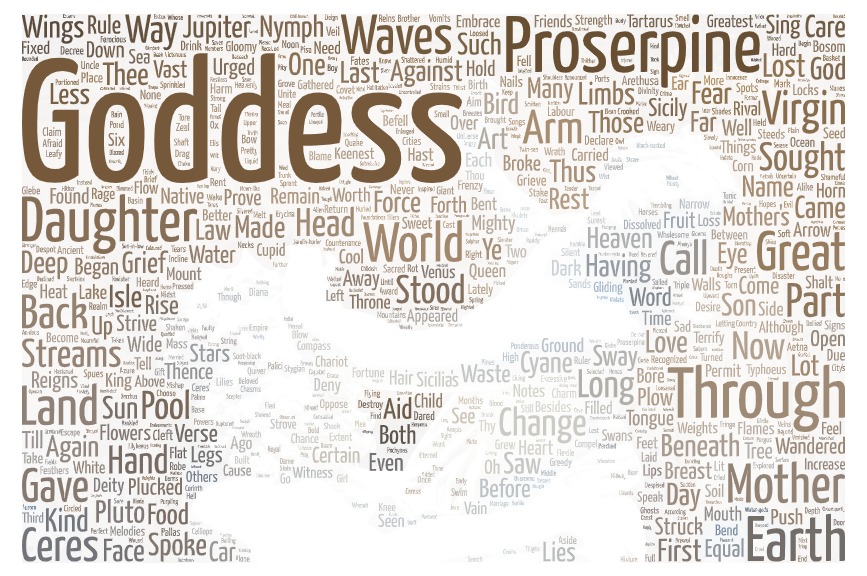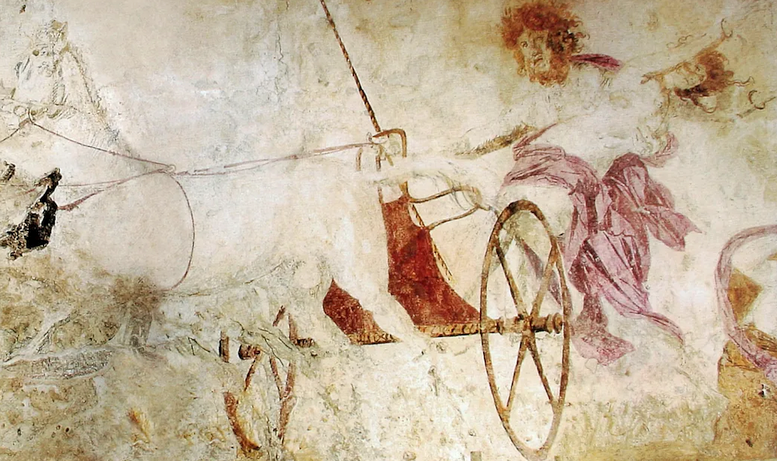A screen of foliage filters out the sun.
Boughs keep it shaded, and the dewy ground
puts forth assorted blooms. It’s always spring.
Inside this grove, Proserpina is playing
as she picks violets or bright white lilies.
With girlish eagerness she fills her baskets
and skirt, eager to beat her friends at picking.
Almost at once, Dis sees her, wants her, steals her.
So quick is love. The terror-stricken goddess
calls sadly for her mother and her friends —
her mother more. She tears her robe’s top hem,
and gathered flowers spill from her loose clothes.
She is so innocent in her young years
that this loss also makes the virgin weep.
The rapist drives his chariot, exhorting
each horse by name. He shakes the dark-rust reins
that drape their manes and necks.—from Ovid’s Metamorphoses 5.415–431, translated by Stephanie McCarter[1]
This month’s Book Club selection is taken from Ovid’s Metamorphoses. We previously read Books 1 and 2 in May 2023, and Books 3 and 4 in July 2024. This month, we will read Books 5 and 6.
In Book 5, Ovid brings us to Sicily. Venus watches Proserpina gathering flowers in a grove. The virginity of Ceres’ daughter is an affront to the Goddess of Love who is reminded that Pallas and Diana have escaped her. She orders Cupid to strike Dis (Pluto) with a barbed shaft through the heart. And so begins the transformation of innocence into sorrow.
Publius Ovidius Naso was born at Sulmo in 43 BCE[2] and initially studied law, but soon pursued his love of poetry, and the amorous side of life in Rome—illustrated in his early works, the Amores and Ars Amatoria, (The Art of Love) which include illusions to classical myths. The Metamorphoses incorporates a series of mythological stories, connected with various narrative devices and with the broad theme of transformation of bodies into new shapes.
He was initially held in favor by the emperor Augustus until, apparently due to some indiscretion, Ovid was exiled from Rome to Tomis on the Black Sea[3] where he continued to write. He completed his last three major works while in an unhappy exile from Rome. In one of these, the Tristia, he laments not having had enough time to refine the Metamorphoses before he had to depart Rome.[4] He died in Tomis in 17 CE.
You can read any translation you like. Here is a selection of versions that are available online for free:
A.S. Kline— online at the University of Virginia.
Frank Justus Miller (1916) — read online or download in various file formats, at archive.org.
Brookes More (1922) —online at Perseus, where you can also find the Latin text. More’s
translation is also online at theoi.com and is also available as a Librivox audio recording at archive.org.
Mary Innes (1955) — read online or download, at archive.org.
Henry T. Riley (1889) — read online or download, at archive.org.
Stanley Lombardo (2010) — read online or download at Purdue University Fort Wayne, IN.
Ian Johnston (2011) — read online or download at Ian Johnston’s website, Johnstonia Texts.
Discussion starts and continues in the Forum.
We will meet via Zoom on Tuesday, August 27 at 11 a.m. EDT.
Happy reading!
Notes
1 Ovid, Metamorphoses, translated by Stephanie McCarter (United States, Penguin Books, 2022) 140-141.
2 Ovid, “Introduction,” Metamorphoses, translated by Mary M. Innes (London, Penguin Books, 1955) 10–12.
3 Wikipedia article Exile of Ovid
4 Samuel J. Huskey, Ovid’s Metamorphoses in Tristia I, 1, (University of Oklahoma, Academia.edu) 1.
Image credits
Wordcloud based on Gian Lorenzo Bernini: The Abduction of Proserpina, 1622.
Photo: Kent Wang CC BY-SA 2.0, via Wikimedia Commons
Retrieved August 2024
Hades Abducting Persephone.
Photograph: Yann Forget (2020 January 10). Retrieved from Wikimedia.org on 2024 July 1. Photographic image is in the public domain.
The image shows the restored original wall painting, on display at the Museum of the Royal Tombs of Aigai, found in the royal tumulus of Philip II of Macedon and several of his close relatives including King Arrhidaeus, Alexander’s half-brother. The wall painting dates from circa 340 BCE. The fresco depicts the abduction of Persephone by Hades. The site, first excavated in 1937, is still the subject of archaeological research.

